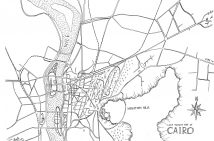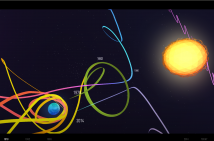Submarine Channel

Interactive projects about online privacy
Top5's
Interactive projects about online privacy
Most of us don’t seem to care much about our online privacy. Why should we? And what are the effects of living in a world where we are connected –observed even– 24 hours a day? In these five interactive projects, directors and designers address one of the most important issues of the information age: the recording and exploitation of our personal data and what should be our basic human right; the right to be “off the grid”.
By Remco Vlaanderen
1. White Spots
A Journey to the Edge of the Internet
The first thing the White Spots app does when you start it in VR mode is to visualize the invisible mobile and wifi networks all around you. I found out that here, in the densely populated area of Amsterdam West, we live in an electromagnetic jungle. Too many signals to count. It feels like taking a peek in an alternate universe that you never get to see. A reality that is always there and from which there is no escape. This is where White Spots comes in.
The White Spots app offers you an escape route. You can use the world map to travel to a “white spot” – an area without coverage- closest near you. The green markers on the world map give access to short video stories from all over the world about life off the grid. Like the South African entrepeneur who wants to bring internet to an underprivileged neighborhood in his city. Or an Armenian writer who chooses to live completely off the grid. If you want to speak to him, your only option is to visit the local bar that he frequents and hope that he will show up. The app also features 360 video recordings of actual white spots. Watching these makes you painfully aware that we are about to loose something important: the option to opt out, to disconnect. White Spots is a beautifully designed app that illustrates the significant divide between the connected and unconnected parts of the world.
The best way to experience the app is with Google cardboard, but it also works without. White Spots is a collaboration between information designer Richard Vijgen, artist Jacqueline Hassink and director Bregtje van der Haak.
2. Super Stream Me
Premise: Two Dutch presenters hook up with a web cam and stream their lives online 24/7 for 18 days. Goal: to find out how ‘open’ we are when our entire life is made public. What does it mean to have no control whatsoever over which parts of your life are private and which aren’t?
Launched in November 2015, Super Stream Me turned was an interesting psychological experiment that weighed heavily on the mental health of its two subjects. Launched in November 2015, viewers could view Tim’s and Nicolaas’s livestreams on the Superstreamme website, alongside real-time data, such as their heart rate and locations. The thin line between being a viewer and being a voyeur became diffused almost instantly after the livestream went live, when Tim had to visit the little boy’s room to do a number two.
The strain on the two presenters proved to be too much. In the second week, Tim started to experience symptoms of a burnout caused by severe stress. This prompted the duo to end the experiment on day 15 – three days before the official conclusion.
The many hours of livestream footage were edited into a two-hour documentary film. And you can find many clips from the experiment on Super Stream Me on the website (in Dutch).
3. ClickClickClick.Click
If you were around in 1994 and not a foetus, you might remember the Really Big Button That Doesn’t Do Anything? This Internet phenomenon served as a funny commentary on our online behavior in those days. Yes kids, this was the year that the first web browsers that were able to display graphics became popular. Every self-respecting web page at that point replaced the text links in their menus by buttons. Because hey, buttons were every so much more engaging than those blue hypertext links.
Clickclickclick.click is like an update of the Really Big Button That Doesn’t Do Anything. When you enter the website, all you see a big green button at the center of the page. A voice over welcomes you. And then it starts to analyse you, “the subject,” based on the way you handle your mouse and on where you click and how often. In a tongue-in-cheek way, Clickclickclick reveals the many browser events that commercial websites use to monitor your online behavior and manipulate you into staying longer on their websites and buy their products.
A project by Studio Moniker and VPRO Medialab.
4. Do Not Track
Do Not Track is simply brilliant. Out of all five projects in this Top 5, Do Not Track is arguably the most powerful tool for creating awareness on a subject that most people know far too little about; online privacy and tracking software. After watching all seven episodes, you will have gained a deep understanding of how your private information, your online and offline activities, and your identity are recorded and used for monetary gain. But director Brett Gaylor goes one step further. By allowing the web series to access your social media profiles, your favorite websites, your cookies, your location, etc., you get to experience first hand how much your tracking data actually reveals about you. And believe me, they reveal a whole lot more about you than you think! After watching Do Not Track, I installed a couple of tools and browser addons suggested by the creators of the series to help me protect my online privacy.
Each episode covers a different subject. There’s Big Data, Social Networks, the Filter Bubble… Each episode has its own look-and-feel. Some episodes are animated. Some are interactive. Some episodes compile a variety of clips from online media archives in real time into a seamless online video.
Directed by Brett (RIP: A Remix Manifesto) Gaylor, Do Not Track is a collaboration between Upian, the NFB, Arte, BR, and others.
5. Wifi Whisperer
Your phone is leaky. It’s especially leaky when you use and unsecured public network and Wifi Whisperer reveals that.
We witnessed this installation by digital artist and creative coder Kyle McDonald (in collaboration with Surya Mattu) at the IDFA Doclab Elastic Reality expo in Amsterdam in 2016. Wifi Whisperer visualizes on four monitors the data that is leaking from your mobile devices. And it enters whatever data it finds, like your name, a web pages you visited, or photos you post on your Instagram account (without your permission) in a search engine and outputs the results on the screens. What makes this installation extra creepy is the computer voice that continually whispers whatever it finds out about you and other people near you who share the same unsecure network. Like its gossiping about you – sharing your innermost secrets.
McDonald doesn’t even need to install trackers or cookies on your device or hack it to access this data. “This is something that anyone can do with their laptop,” says McDonald in an interview on coolhunting.
All five projects in this Top 5 were presented at the Netherlands Film Festival and at the IDFA Doclab in 2015 and 2016.
Remco is the editor of Submarine Channel, and he occasionally produces animation and game projects, such as the interactive graphic novels The Art of Pho and Ascent from Akeron. He initiated and ran the popular website about film title design, 'Watch the Titles' for many years. And he recently launched Screendiver.com – an online directory where readers can discover the best interactive comics.





